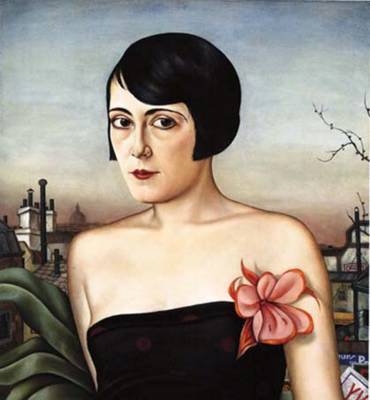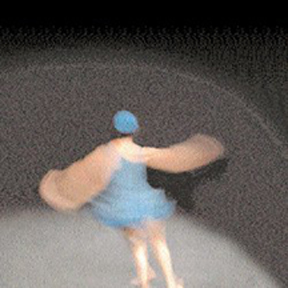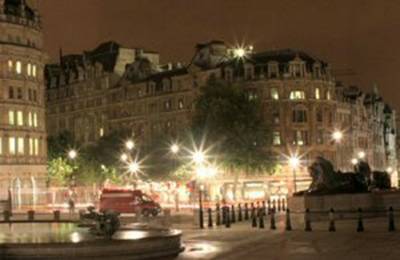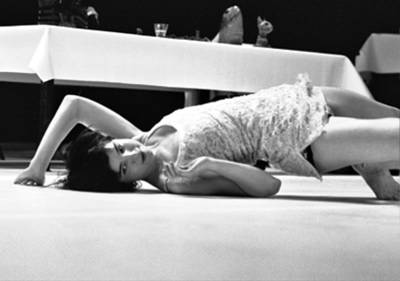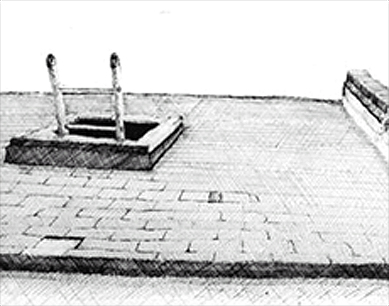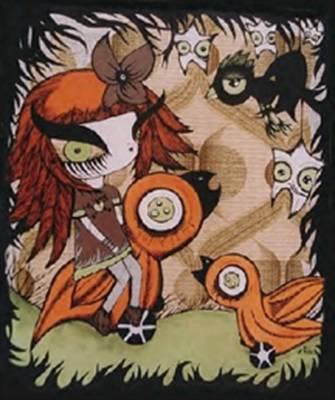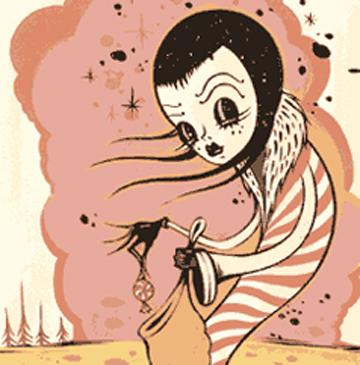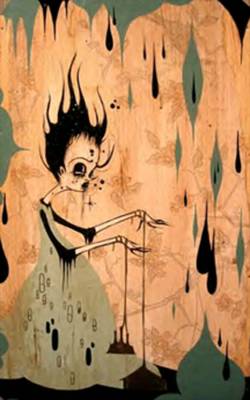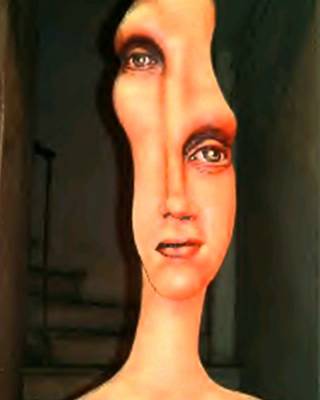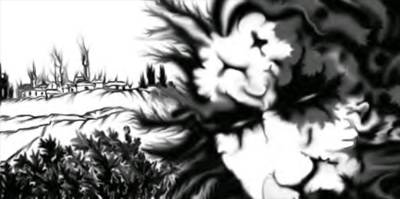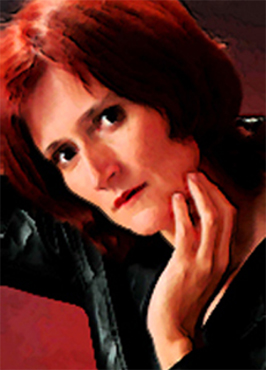
BOOKS/WRITERS
Lives Mini-view: Marianne de Pierres, novelist
“An anti-hero is kinda easier to relate to, in my mind...as a friend she'd die for you -- and she'd be handy to have around when you got into a fight.”
MEET: PARRISH PLESSIS
Parrish is the protagonist of my three-book series, which begins with the novel
"Nylon Angel."
She becomes, in the course of things, a tough action hero, a grrl who decides to take back control of her life.
She has features of both hero and anti-hero. An anti-hero is kinda easier to relate to, in my mind, and I certainly wanted to make a few statements about beauty and [societal] expectations of women.
On the other hand, it
is SF and you’ve got to take a few leaps, so she's got some enhancements.
TERRITORY
The books are set in a near future Australia with very clear lines of wealth and poverty.
The Tert, where Parrish resides, is what’s left of a vast villa-tropolis that has degenerated into a slum.
I think the Tert came from my own experience living in a flat complex: hi-population,
lo-rise. You could hear what everyone was doing and it wasn't always pretty.
I used to think about how easily it could fall to slum living, under certain circumstances. I also foresee one giant mega-city along the east coast of Australia. We've already gone a good way towards realizing that.
PARRISH: THE GOOD THING ABOUT BAD GIRLS
As a characterization: She’s so bombastic and abrasive she could be a real handful, but as a friend she'd die for you -- and she'd be handy to have around when you got into a fight. So, yes, I'd like to know her.
Her character is definitely pieces of people I've known. Believe it or not, Parrishes exist --they’re just not gun-toting.
The 'good grrl' attributes are evident in her obsession with personal freedom, and in her compassion for the forgotten and mistreated.
I think everyone would like to kick ass sometimes. No safer, more legitimate way to do it than on the shoulders of a fictional character.
Also, her brand of justice vacillates up and down the spectrum of an 'eye for an eye' and 'live and let live', which I think is where most of us operate.
As an aside: One of the things I am conscious of is this myth that physically strong, capable women are men in disguise.
Therefore, if you write about a female character with those attributes, it shows you're actually doing a poor job of characterization, because woman just aren't like that.
What crap! I rail against this because I think it contributes to the ongoing disempowerment of women and the perpetuation of the 'weaker sex' syndrome.
Many woman can handle themselves better than their male counterparts. That doesn't make them any less female, and while we stay in those stereotypes, women will continue to be physically abused.
I'm not suggesting that women should become combative (like Parrish!), but neither should we accept a divisive perception of ourselves. That's a bit of an off-the-subject rant, sorry!
BELIEVE IT: RESEARCH
I'm an expert on a number of things at a
very superficial level. I think that the more you write fiction, the more you realize how little you know.
I've researched everything from voodoo, chaos theory, the autonomic nervous system; to guns and knives, wireless technology, Australian aboriginal mythology and the properties of mould.
THEMES
Parrish's journey through Dis in Code Noir is an allegory for Dante's
"Inferno."
I wanted to introduce notions of spiritualism into the story, but the overall theme remains the same: the price of personal freedom is social responsibility.
I guess spiritualism and its mysteries recur in much of my short fiction. Of course, writing about spiritualism with Parrish crashing around in amongst it is an entirely different experience than in other instances of my work.
I am also committed to exploring the concept of family and community – what it means, how it works, how it serves the human race.
I believe that with better understanding and a conscious effort to nurture the health of these social structures, we can make the world a better place.
THE LONG AND SHORT OF IT
Book-length fiction vs. short fiction: Actually I enjoy both mediums. Short fiction often gives you an opportunity just to play in a world. I personally prefer a conclusion in a short story, and so many of them seem to puff out because a good ending is so damn hard to do.
COMING UP
The last book in the trilogy (with a working title of
"Shatter Deluxe") is due for release in the UK in May 2005.
Soon after that, “Nylon Angel” (book one) comes out in the US.
My next project is something I'm very excited about. It's set in a city of clubs where it is always night and you can only gain admittance if you are under the age of twenty three.
It's a hedonist's paradise where the pay-off is death from adrenal burnout.
The book explores themes of ageism and the contrasts between extremes in lifestyle. It will be a very confrontational story.
I also have a Parrish short story in the September 2004 issue of
"Simulacrum."
It's set between book two and three, and is about 'Parrish the Warlord' getting it wrong.
MORE PARRISH?
I guess that's up to the readers! There's an embryonic reader's community just started up on livejournal called
Parrish's Patch. I'll be checking in with them to see what they think.
Bio: Australian speculative fiction writer Marianne de Pierres is the author of
"Code Noir" and
"Nylon Angel." Her short stories have appeared in anthologies alongside authors like Harlan Ellison, Gene Wolfe, Jack Williamson and Terry Dowling. She is currently at work on the third book in the Parrish Plessis cyberpunk series.
Official site: Marianne de Pierres
Read interviews with other creative artists in the DEC/JAN issue of "Arte Six."
Original post date: OCT/NOV 2004

BOOKS/WRITERS
Excerpt:
"Code Noir", by Marianne de Pierres
The Tert boundaries spread peninsular-style to the south of the super-city, Viva. Slick and sick Fisher Bay on one side, the ailing Filder River on the other: a despoiling one hundred or more klick strip of rabble – animate and
inanimate.
It was once a massive engineering works site that got ripped down and disguised as a villa-tropolis - until the locals started showing signs of heavy metal poisoning from the industrial landfill.
Now it was a weird territory for serious offenders. Every kind.
A sterile strip of wasteland like an excessive firebreak divided it from the rest of humanity.
To look at, nothing much had been altered by the short, intense war. The already patchwork human dwellings that had been damaged were now
re-patched and as functional as they would ever be. Not so their inhabitants.
Nearly a thousand people died in a few days. The stink had got so bad that they'd allowed the militia in to clean up. The mass cremations happened on the wasteland near Teece's patch. Sometimes when I woke up in the night I could still smell it.
The Media gave all the death a heap of airtime. One-World, Common Net, Out-World - you name it. Nothing like a stack of burning, expendable bodies to boost the ratings!
Priers – pilot/journo’s and their intrusive
cam-cording ‘Terrogator’s in fruited-up ‘copters - supervised the whole affair, jostling their militia lackeys out of the way for the best, close-up footage. Image scavengers!
I became so desperate to lay my hand on some anti-aircraft hardware Teece had practically chained me up to stop me chucking grenades at them...
I jogged onwards until my energy waned then I walked. Eventually I hauled my arse into a cafe for beer and food. Transport was around: scooters and Pet's.
I'd never been a fan of Pet’s. It didn't seem right riding on a back of a kid even if it was half mekan. A more pragmatic person would have said,'yeah but you're putting cred in their pockets.' But practical isn't always
my bag. More like hyped-up gut reaction! And getting worse.
The food was average but the beer was good. Funnily enough it was one of the few things in The Tert that always was. Humanity might be on the fast track to hell but the beer in Tert town’d always be cold.
I sipped my way through it and enjoyed being alone for the first time in a while.
Not that I was really alone here. Since Jamon went down with the Cabal spear in his back, and I’d put a bullet in a shape-shifter named Io Lang, everyone knew me. Sometimes it was good, mostly it wasn't, and some of the time I had
to stop myself from hurting them.
See, I was carrying a load of aggression inside that wasn't entirely mine.
It had to do with the needs of the parasite and the way it manipulated my body. The more epinephrine that flowed, the fatter and happier it got. The less human I got.
Most of the time I controlled it. I'd even taken up meditation. But sometimes it got me so bad anyway that I turned rabid: angry and lusting. I likened it to a werewolf in the change - not that I'd ever seen one – but sometimes the need overwhelmed the rest.
I guess you could say there was a new confidence in my look now - but it was shadowed by a dark preoccupation. I'd become the sort of person I used to admire - the person no one messed with, the one with nothing to lose.
It wasn't the way I expected it to be. Not one little bit. When is it ever? People didn't mess with me but they competed endlessly.
I drained my tube and asked for another. I wanted to get smashed but I didn’t have time.
Besides, even that pleasure denied me. The parasite kicked in when I reached a certain point of getting stoned and annulled the effects. You wouldn't think you could crave waking up with a mother of a hangover and a mouth drier than six-month-old bread. But I did.
One-World blathered on the bar vid. I switched sides of the booth to avoid seeing it. I didn’t watch net news anymore on account of a personal grudge.
Business conglomerates and politicians used to control the world. Now the steering wheel was in one set of reality-murdering hands.
The Media. They’d tried to frame me for the death of Razz Retribution, media hound and presenter. A capital offense. One I entirely did not commit.
I was taking that grudge to the grave.
I didn’t forgive a lot. Or forget.
For the moment though, they seemed to be leaving me alone. Too much public controversy, I guessed, over the truth behind Razz Retribution’s murder.
Normally they didn’t give a canrat teste about the veracity of their viewing matter, but somehow enough doubt had separated the audience’s collective mind. Opinion had divided into camps. Parrish guilty. Parrish not.
As I knocked back my second tube a young, slick turk came hanging around my table. I picked him straight away - competitor!
I raised an eyebrow. 'Problem?'
He was lean and dark, and from the way he arched his back reflexively, on a testosterone high. Hard to say if it was natural or paid-for.
‘No problem,’ he said ‘Jus’ enjoying the view. Heard you’re the one that’s pretty dangerous? That true?’
I sighed heavily. Whatever tiny interest his looks might have aroused in me, dampened instantly.
'You got the wrong person.'
'Pity,' he said. 'I been wantin’ to meet her. Real bad.'
'Whyso?' I asked, vaguely curious.
'Heard she could match it with anyone. Heard she was real good at one-on-one.'
'Uhuh.'
Now his mouth was geared up there was no stopping him. 'Yeah. I wanted a piece before she got disappeared.’
‘Disappeared?’ Now he had my interest.
'There's talk,' he mock-whispered and winked, sidling closer. ‘Someone’s put cred out to bag her. I got friends who know.’
I'm pretty funny about my personal space but I let him into the fringes of it. My hand fell casually to my holster.
Hormone boy stopped dead when he saw what I was packing but I had the Luger drawn in the second it took him to breathe.
‘Siddown!’
His legs folded under him, so that he just caught the edge of the booth seat. His face flushed with anger and embarrassment.
'You are her. I knew it,' he cried.
He was beginning to irritate me. 'Who wants her?'
A smirk ventured across his face. 'What's it worth?'
It was the second time someone had said that to me today, only this time I wasn't feeling so charitable.
I examined him closely, my free hand fingering the collar of poisoned pins around my neck. 'You could get to keep your own eyes. You might not need bone transplants. The benefits are endless, really.'
His smirk transformed back to anger – and a flash of fear. A reputation could be handy.
I shifted my aim to the spot right between his legs. I expected he was keen to keep his gonads in working condition.
'Names,' I said quietly.
Sweat appeared on his upper lip and his hair-freeze began to thaw. ‘Someone up Tower Town way.’
My breath caught in my chest. I leaned forward. Tower Town was Daac’s patch. Bastard!
Hormone boy saw my reaction and sucked up a deep breath like it might be his last.
I jerked the pistol, firing it off reflexively. The booth's table splintered to pieces.
Vaguely, I saw people scrambling away, but my sanity had waned as the parasite gorged greedily on my reaction to the news.
Somehow hormone boy avoided the bullet, crab crawling, all the way to the door.
I let him go, flicked some credit the bartender's way for damages and got the hell out of there.
The backwash of my neuro-chemical reaction struck as I lost sight of the cafe. I went down in a heap with the barest survival instinct to get my back against something solid before the hallucination took hold. It was the same
as last time and the time before...
An Angel, massive, rose from a stream of blood, spraying droplets. My blood.
'The change is close, human.'
I screamed my denial, a long, terrified sound.
Excerpted from
"Code Noir" (Orbit).
© 2004, Marianne de Pierres. All rights reserved. Used with permission.

